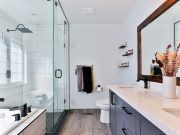Negative space is integral to the design, though it often goes unnoticed. It can create visual interest, balance elements on a page, and focus attention on the essential parts of a design. By understanding how negative space works, designers can effectively use this powerful tool to create striking visuals. This article will explore the power of negative space in design and discuss how it is used to make an impactful statement.
The Power of Negative Space
Negative or white space refers to a design or image’s empty or unoccupied areas. While it may seem counterintuitive to include empty space in a design, negative space can be a powerful tool for creating balance, emphasis, and visual interest.
In design, negative space can be used to create contrast and highlight important elements. By giving elements room to breathe, negative space can draw the viewer’s eye to the most important parts of the design and create a sense of hierarchy. Additionally, negative space can be used to develop a sense of balance and harmony by distributing visual weight evenly throughout the design.
In photography and art, negative space can be used to create a sense of depth and focus by contrasting the subject or focal point of the image. Negative space can also create a sense of tension or anticipation, leaving the viewer wondering what will fill the empty space.
Overall, the power of negative space lies in its ability to create a sense of balance, contrast, and visual interest. By intentionally including empty or unoccupied areas in a design or image, you can create a more dynamic and engaging visual experience and draw the viewer’s attention to the most important parts of the composition.
Definition & Examples of Negative Space
Negative space is the area around and between the main elements in a design or image. It’s the empty or unoccupied space that surrounds a subject. It can be just as important as the positive space (the subject itself) in creating a balanced and visually appealing composition.
One common example of negative space is the white space in typography. The spacing between letters and lines of text is just as important as the text itself, as it can affect the readability and overall look of the design. Similarly, in graphic design, negative space can create contrast and emphasize certain elements in a composition. For example, a logo with a simple design and a lot of negative space can be more visually striking than a cluttered design with too many elements.
Photography can also use negative space to create a sense of depth and focus. For example, a portrait with a blurred background creates negative space around the subject, which draws the viewer’s attention to the person’s face. Additionally, negative space can create a sense of tension or anticipation by leaving the viewer wondering what will fill the empty space.
Negative space is a powerful tool for creating balance, emphasis, and visual interest in design and art.
Benefits of Using Negative Space in Design
There are many benefits to using negative space in design, including:
- Improved readability: Negative space can help separate text, making it easier to read and understand. By creating enough space between lines, paragraphs, and individual letters, designers can ensure the text is legible and visually pleasing.
- Increased visual impact: Negative space can help draw the viewer’s eye to the main elements of the design, making them stand out more. By creating a visual hierarchy emphasizing important elements, designers can make their designs more engaging and effective.
- Greater clarity: Negative space can help simplify the design and make it easier to understand. By removing unnecessary elements and focusing on the most important parts of the design, designers can make their message clearer and more concise.
- Better brand recognition: Negative space can help create a strong brand identity by making the logo or other visual elements more memorable. A simple, well-designed logo with negative space can be more easily recognized and associated with a particular brand or product.
- More creative opportunities: Negative space can inspire designers to think more creatively and develop innovative solutions. By using negative space unexpectedly, designers can create unique and visually striking designs that stand out from the crowd.
Overall, using negative space in design can lead to more effective and engaging visuals, as well as a stronger brand identity and more creative opportunities.
The Difference Between Positive and Negative Space
Positive space refers to the main subject or element of a design or composition, while negative space is the area around and between the main elements. Positive space can be seen as the foreground, while negative space can be seen as the background.
Positive space is typically the focal point of a design, while negative space supports and enhances the positive space. For example, in a photograph of a person, the person would be a positive space, while the background and surrounding areas would be a negative space. The negative space can be used to create contrast, emphasis, and balance in the composition, making the positive space more visually appealing and engaging.
Another way to consider the difference between positive and negative space is to consider them solid and void spaces, respectively. Positive space can be seen as the solid elements that are tangible and can be touched or interacted with, while negative space can be seen as the void or empty spaces that surround the solid elements.
The relationship between positive and negative space is crucial in design, as they work together to create a harmonious and balanced composition. By manipulating the amount and arrangement of negative space around a positive space, designers can create different effects, such as making the positive space stand out more, or creating a sense of movement or flow in the design.
Overall, understanding the difference between positive and negative space is essential in creating effective and engaging designs. By carefully considering the relationship between these two elements, designers can create visually striking, balanced, and easy-to-understand compositions.
Common Mistakes to Avoid with Negative Space
Working with negative space in design can be challenging, and designers can make several common mistakes. Here are some of the most common mistakes to avoid when using negative space in your designs:
- Filling up all the space: One of the most common mistakes is to fill up all the available space with content or design elements. This can make the design look cluttered and overwhelming, making it difficult for viewers to understand the message.
- Ignoring the balance: Negative space needs to be balanced with positive space to create an effective design. Ignoring this balance can make the design look lopsided and unprofessional.
- Overcomplicating the design: While negative space can be used to create interesting and complex designs, it’s important to avoid overcomplicating the design. Too many elements or too much negative space can confuse the viewer and detract from the message.
- Using too much white space: White space, or empty space, is an important part of negative space design. However, using too much white space can make the design look sterile and boring.
- Lack of intention: When working with negative space, having a clear intention and purpose is important. Without intention, the design can lack direction and focus, leading to an ineffective design.
To avoid these common mistakes, it’s important to approach negative space design with a clear plan and purpose. Keep the design balanced and intentional, and avoid cluttering the space with too many elements or filling up all the available space. With practice and attention to detail, designers can effectively use negative space to create beautiful, engaging designs.
Conclusion: Maximizing the Impact of Negative Space
Negative space can be a powerful tool in design, allowing designers to create interesting and engaging compositions. By using the area around and between design elements, designers can create a sense of balance, contrast, and flow that can make a design more visually striking and effective.
However, working with negative space can be challenging, and it’s important to avoid common mistakes such as overcomplicating the design, ignoring balance, or using too much white space. By being intentional and purposeful in their use of negative space, designers can maximize its impact and create beautiful and effective designs.
Overall, understanding the principles of negative space and how to use it effectively is essential in creating successful designs. Whether it’s in graphic design, web design, or other fields, the power of negative space can make a significant difference in the impact of a design. With practice and attention to detail, designers can use negative space to create visually stunning and effective designs that leave a lasting impression on viewers.






























